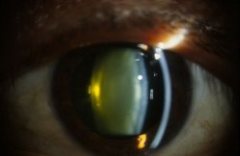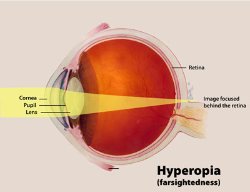|
EYE CONDITIONS Many eye and systemic conditions can be diagnosed by the doctors of INFINITY EYE CARE CENTER. Our website highlights a few common eye conditions. If you or a loved one has been recently diagnosed with an eye related issue by our doctors or others outside our practice and you have questions please feel free to contact us office. We are here to help and are always happy to answer any questions you may have now or in the future. Just like our motto states, "EYE CARE FOR LIFE." Cataracts
A cloudy or opaque area in the normally clear lens of the eye. A cataract occurs when the natural clear lens changes in structure, appearance, and function. Some of the causes include: ultraviolet exposure, steroid use, diabetes, smoking, and normal aging. Once mature, the cataract can be removed and an artificial lens is inserted into the eye. Some of the artificial lenses allow the patient to see up close and far away without the need of having to use glasses or contacts for a majority of the day. Cataracts can affect your vision, but can be fixed with a simple out-patient surgery. The doctors at Infinity Eye Care Center work closely with local surgeons and will coordinate your care before and after surgery. GlaucomaA group of disorders leading to progressive damage to the optic nerve, and is characterized by loss of nerve tissue resulting in loss of vision. Glaucoma can be diagnosed, monitored, and treated, in office, by Dr. Smith and Dr. Manning. In most cases, the progression can be slowed or stopped to preserve your vision. Our clinic uses dilated retinal exams, corneal pachymetry, digital retinal photography, and GDX technology to diagnose and monitor the health of the optic nerve. Macular Degeneration
An eye disease affecting the macula, the center of the light sensitive retina at the back of the eye, causing loss of central vision. Dr.'s Smith and Manning can show you the health of your retina with our state of the art fundus camera. We can monitor your macula for any early signs of the disease. It is highly advised to NOT SMOKE, wear UV protection, eat plenty of fruits and vegetables, and to have yearly eye health exams. Refractive ConditionsMyopia or " NEARSIGHTEDNESS"
A vision condition in which you can see close objects clearly, but objects farther away are blurred. In some cases the eye is "longer" than normal leading to myopia. Myopia in young patients can increase with excessive texting and computer use. Myopia can be corrected with glasses and/or contact lenses and for individuals interested in not wearing glasses or contacts we can advise you on surgical options to correct your vision like LASIK. Hyperopia or "FARSIGHTEDNESS"
A vision condition in which distant objects are usually seen clearly, but close objects do not come into proper focus. Hyperopia can be corrected with glasses or contacts but not usually LASIK. Latent HyperopiaThis is a subset of Hyperopia. It is usually caused by weak focusing muscles of the eye. This refractive condition if undiagnosed may lead to decreased grades, headaches that occur after intensive near tasks, decreased comprehension, and in some cases a misdiagnosis of attention deficit disorder. The lens focusing system in the eye becomes unstable due to weak ciliary muscles allowing the lens to over focus while looking up close or far away. Most patients tend to grow out of this as they mature. Presbyopia or "MATURING EYES"An age-related vision condition in which there is a gradual loss of the eye's ability to focus on near objects. This is caused because the focusing mechanism of the lens weakens and the lens hardens. A common complaint is that, "my arms are not long enough anymore while I read." Presbyopia is corrected with multi-focal glasses or contacts. This condition usually can not be corrected with laser eye surgery. Amblyopia or "LAZY EYE"This condition is considered a diagnosis of exclusion. All other eye conditions/eye diseases have to be ruled out and if nothing is found then you may have amblyopia. Many causes exist that include: congenital cataracts, corneal scars, muscle imbalances that cause the eye to turn, and uncorrected refractive errors like hyperopia. If the cause is determined and corrected before the age of seven then there may be a possibility for visual improvement. One way to deal with amblyopia is through the use of occlusion therapy. In the past, the good eye was patched with a pirate patch. Today, our clinic uses eye drops to cause the good eye to be slightly blurry thus making the weaker eye have to work harder. Astigmatism or "FOOTBALL SHAPED EYE"This refractive condition that causes light to focus at two different points inside the eye. This usually causes the patient to squint. This refractive condition can lead to headaches, light sensitivity, and decreased concentration. Glass, contacts, or LASIK can correct most levels of astigmatism. Corneal ConditionsThe cornea is the clear window of the eye. It is the nearly invisible front structure that allows light to pass through it to the crystalline lens. If there are scars, ulcers, dystrophies, or keratoconus then light may not pass through the cornea correctly. UlcerAn ulcer can be caused by a variety of things like: abuse of soft contact lenses, autoimmune diseases, severe dry eye, or a foreign object that strikes the cornea allowing bacteria to enter the structure. DystrophyA dystrophy usually has a genetic variant that causes the cornea to become cloudy over time. These usually occur in the 40-60 years of life. It can present in one or both eyes. Symptoms include: sensitivity to light, glare, and blurry vision that can not be helped with glasses or contact lenses. Most cases do not require surgery, but in rare cases a corneal transplant is needed to restore vision. One example of this condition is Keratoconus. It causes the normal round cornea to thin and bulge and to take the shape of a cone. A corneal topographer is a instrument that can give a colored picture (map) that can easily confirm the presence of this condition. If the condition changes the means to correct any vision deficits may include soft contacts, rigid gas permeable contacts, or surgery. |











